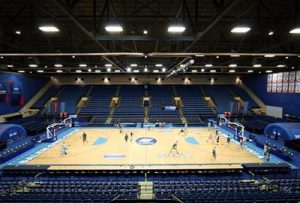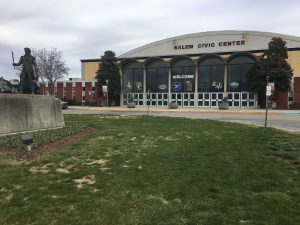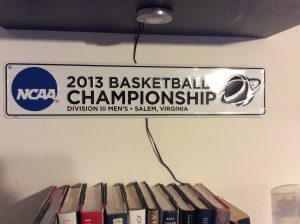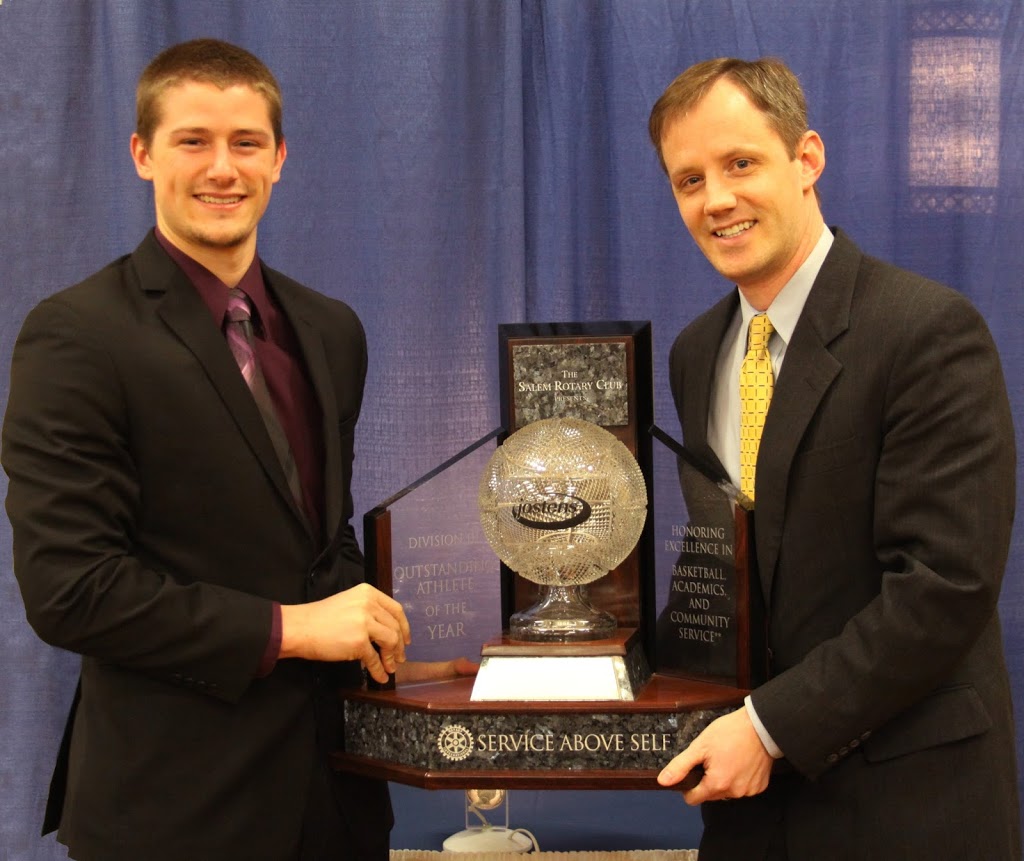
Salem Civic Center prior to the 2017 men’s basketball semifinals. Courtesy: d3photography.com
The NCAA, or more particularly the particular sports committees, are going to regret the decision to leave Salem, Virginia.
I will admit, that may be pretty blunt and may come from a bias point of view. I have traveled to the Roanoke Valley for NCAA championships since March of 2001. I was introduced to the Salem Civic Center the first season we to put Hoopsville on the air. Pat Coleman invited Jared Rosenbaum and me to what had become the mecca of Division III basketball. Pat’s alma mater which happened to be my alma mater’s biggest rival, Catholic, won the national title that year. It didn’t take anything away from my experience.
I haven’t missed a trip to Salem for basketball since. I have also added a few other trips as well and have now been to over 25 Division III championships in the Roanoke Valley. 17 men’s basketball, 7 football, and 2 soccer. By the time Salem “loses” the football and men’s basketball championships, that total may be 28 or more.
In all those events, not once did I ever think, “I wish the championships had a better place to be. I wish the facilities were better. D-III deserves a better place.”
Not once.

UW-Oshkosh football teams runs out of the tunnel and shower of fireworks onto the field at Salem Stadium in Stagg Bowl 44 last Decemeber. Courtesy: Larry Radloff, d3photography.com
But the men’s basketball and football committees has apparently decided that there are better “facilities” to visit with the championships then Salem. At least, that is what I have been told. “Facilities” was the reason for the decision to leave Salem with football and men’s basketball after 25 and 23 years (following next season) respectively.
Fine. There are flashy new stadiums and arenas to visit. There are apparently members on the men’s basketball committee, at least, who seem to want newer and maybe bigger facilities among other arguments.
Are Salem’s facilities old? Sure. Are they bad? Not in the least. I fear members of the men’s basketball committee have lost focus of the bigger picture while wishing for “better” facilities.
The reason Salem is so well regarded and loved had nothing to do with the facilities. It was because of the experience, especially for the student-athletes, was the best of the best.
As my broadcast partner the last two seasons in Salem for the men’s basketball championships, Lincoln Rose, said during halftime of this year’s men’s title game, Salem “create(s) a national stage, a spotlight for student-athletes who put in put in just as much hours and sweat-equity as well as balance that with academics and you really reward them for all of their hard work and give them a memory they can take with them.”
I couldn’t say it better myself. Salem has provided one of the most amazing championship experiences not only in Division III but in Division II as well. I’d even argue they beat out some of the D-I experiences that I have been part of as well.

Babson men’s basketball practicing at Salem Civic Center (Courtesy: Babson Athletics)
Salem has made sure the student-athletes feel special. Salem has put in place things that are now standard for all Division III championships: mementos for the student-athletes, community service events, host families for each team, and more. What Salem has started and created is now standard for all Division III championships and even other events throughout the NCAA. And Salem is never satisfied with the status quo.
By the way, “Salem” is an easy catch-all for a lot of individuals. Carey Harveycutter, the director of tourism for the City of Salem, is a huge advocate of student-athletes, highly respected in the NCAA. John Saunders was Harveycutter’s right-hand man until he recently retired and has made sure things run smoothly behind the scenes. Brad Bankston is one of the most respected individuals in Division III as the long time commissioner of the Old Dominion Athletic Conference and works to put out any fires. J.J. Nekeloff does more than his assistant commissioner and SID role for the ODAC would imply, running media operations like a well oiled machine. And there are more from the ODAC (including member institutions) and the Salem Civic Center event staff who help in small and large ways. I haven’t even mentioned the countless numbers of volunteers who are everywhere and always with a smile on their faces.
I never hear anyone complain. I never see someone roll their eyes. I see ridiculously long hours and incredible pride.
And while “facilities” is the reasoning, Salem has always worked to improve their facilities and experience. Every single seat in the Salem Civic Center has been replaced, the signage and accents around the walls have all been changed and upgraded, they have replaced the arena’s lighting system, brought in spotlights, even toyed with specialty, show lighting in past years. This is the second or third basketball floor in 23 years, there are tunnels for the teams to run through, video screens to add to the crowd atmosphere, and this year we saw video score tables at center court.

Roanoke College’s Kerr Stadium, site of the Division III men’s and women’s soccer championships in 2016. Courtesy: NCAA.com
Did you know Salem has been using whistle timing systems for more than 15 years? They have finally made their way into the D-I basketball tournaments in the last few years, but Salem made sure the refs whistle stopped the clock for a long time. It is that kind of forward thinking that has made Salem special and made them a championship city.
The city’s respect in the NCAA is so high they were chosen to host the soccer championships with about two months warning when the event was pulled out of Greensboro, N.C. due to the state’s infamous “bathroom bill.” What is significant is Roanoke College’s field is turf. The soccer championships had never been held on anything but natural grass. There were other sites in consideration that had natural grass. The NCAA chose Salem because they knew the experience for the student-athletes wouldn’t be affected.

Outside the Salem Civic Center in 2017.
The student-athlete experience is more important than anything else. In 2013, the men’s championship game was taken to Atlanta, along with D-II, to be part of the 75th anniversary of men’s basketball in the NCAA. Salem was getting the short end of the stick since they had been awarded the bid to host the championship that year. But Salem was asked to do something else: host the quarterfinals and semifinals and do it a week later than scheduled. Anyone who understands how facilities are used and rented knows moving an event by a week is hard to do. Most facilities like the Salem Civic Center have their dates (especially weekends) locked in years in advance. But Salem moved the weekend and easily hosted the elite eight. It was so well done and such a tremendous experience there has been serious conversations of making the elite eight an annual thing in the future. Well… until now.
But the story doesn’t end there. Harveycutter, Bankston, Nekeloff, and others headed to Atlanta to help put the championship game on in ATL. And they brought some ideas back to southwest Virginia with them.
The next December Harveycutter mentioned had an idea for the men’s basketball championship banquet and wondered if I might be available. He had seen the celebration event Division I did featuring Jim Nantz chatting with the coaches and then the student-athletes from each team in a low-key, conversational setting. Harveycutter wanted to do that in Salem, replacing speeches from a player and coach from each team. That made its debut the next year in Salem and lasted for several years, then was replaced with yet another change to the banquet to allow it to be fun and low-key for the student-athletes.

One of the mementos given to the teams who made it to the 2013 quarterfinals in Salem, Virginia.
There are about 500 teams who have been on the “Road to Salem” and not returned with a championship. Do you think those teams have anything bad to say about the experience outside of not coming home with the Walnut and Bronze? I’m confident no one complained about facilities. No one looks around the Salem Civic Center and thinks we are in a crappy situation. No one looks around Salem Stadium and worries the stands aren’t big enough or they are going to collapse. No one. Never. But apparently “facilities” is more important to the Division III committees (and maybe in some part the NCAA) then the overall experience these championships have created over decades.
In the meantime, the “Road to Salem” will lose its luster. The “Road to Somewhere” will mean less especially to the student-athletes who know nothing else. The student-athletes playing today weren’t even born the last time Salem didn’t host the semifinals. This means something to them. This means something to Division III and because “facilities” aren’t up to someone’s par the experience will take at least a four-year hiatus – if not more.

Colton Hunt, left, awarded the Jostens Trophy in 2013 in Salem, Virginia. He is accompanied by then Randolph coach Clay Nunley. Courtesy: Randolph Athletics
In addition, I have to wonder what the NABC does to run their All-Star Game. Salem had a pivotal role in that game every year. And the Jostens Trophy is handed out each year in Salem, but more importantly it is given out by the Salem Rotary Club and administrated by Bankston, Nekeloff, and others.
Starting in December 2018, football and then men’s basketball will have new hosts for at least four years. Good luck to them. They are going to have to replace the hospitality, community experience, and more that Salem has made the standard. I guess they will have some incredible facilities, but I won’t be looking at that. When I watch games, I look at the court and the student-athletes on that court. When I am in a community, I look at what is going on around the game and the experience those teams are having. As Pat Coleman points out, these new sites will have to live up to a pretty high bar, but I guess their new facilities will have them one step ahead in the eyes of some on the committees.
I won’t use the words I am really thinking about this decision. Instead I will say this. I’m disappointed.